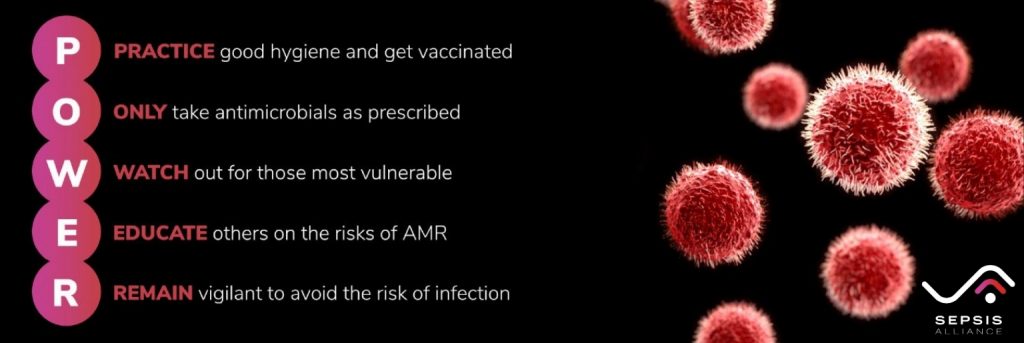New Study Shows High Global Burden of Antimicrobial Resistance (AMR). What Does That Mean for Sepsis?
March 8, 2022
A recent study published in The Lancet looked at the problem of bacterial antimicrobial resistance (AMR) around the world. Antimicrobial resistance occurs when specific strains of bacteria, viruses, fungi, or parasites have adapted to defeat the antimicrobials (antibiotics, antivirals, antifungals, and antiparasitics) designed to treat them. AMR is a growing problem with potentially devastating consequences. The most basic medications we use to fight infections could stop working.
AMR is also under-discussed and misunderstood. According to a Sepsis Alliance survey, only half of U.S. adults are even aware of the term “antimicrobial resistance.” Similarly, scientists need more thorough information to fully understand the problem. “One major challenge to tackling AMR is understanding the true burden of resistance,” the study’s authors explain in their introduction. “Information about the current magnitude of the burden of bacterial AMR, trends in different parts of the world, and the leading pathogen–drug combinations contributing to bacterial AMR burden is crucial.”
The authors set out to address this information problem. Their study is unique because of its global reach. It is one of the most comprehensive pictures of AMR and “superbugs” we currently have.
The Findings
The Lancet study looked at 471 million individual records from 204 different countries and territories across the globe, all from the year 2019. This comprehensive and up-to-date snapshot allowed the authors to get an accurate picture of what AMR looked like in 2019 (and some scientists think COVID-19 may be making the problem worse in the years since). Their study looked specifically at bacterial infections. Had resistant strains of viruses, fungi, or parasites been included, the numbers would likely have been even higher.
According to the study, in 2019, 1.27 million deaths around the world were directly attributable to bacterial AMR. That is a higher number of deaths than are caused annually by either HIV/AIDS or malaria. But that’s not all. The study estimates that an additional 3.68 million deaths were associated with bacterial AMR in 2019. These were deaths in which it’s unknown whether the resistance of the bacteria was the deciding factor in cause of death, but played a role.
Other notable findings from the study include:
- The death rate attributable to AMR is higher in western sub-Saharan Africa than in any other part of the world;
- The death rate attributable to AMR is lower in Australasia (the area that includes Australia, New Zealand, and neighboring islands) than in any other part of the world;
- The top three infectious syndromes associated with AMR were:
-
- Lower respiratory and thorax infections;
- Bloodstream infections;
- Intra-abdominal infections.
- Combined, these top three syndromes accounted for 78.8% of deaths attributable to AMR in 2019.
- Among the most common types of bacteria associated with these deaths were E coli and MRSA.
What This Means for Sepsis
Sepsis, the body’s overwhelming and life-threatening response to an infection, can be caused by any type of infectious bug. As the threat of antimicrobial resistance grows, meaning fewer bugs respond to the drugs we use to treat them, more infections will progress into sepsis. Sepsis cases will become harder to treat, which means that more people with sepsis will experience negative outcomes. This can include amputation and death.
As we see in the study’s findings, AMR is a global, large-scale problem, and even though it is not very well understood, it is becoming more common. AMR has a direct impact on sepsis and the people affected by it.
What You Can Do to Stop AMR
These findings can seem daunting and frightening. But there is some good news: we each have the power to help stop AMR in its tracks.
By preventing infections through our individual actions, such as keeping good handwashing habits and getting vaccinated, we reduce the risk of contracting or spreading resistant bugs and making the problem worse. Another crucial way to help stop AMR is by only taking antimicrobials when they are prescribed. Overuse of antibiotics and other antimicrobials gives infectious bugs more opportunities to learn how to outsmart our weapons against them.
As an individual, your actions matter! You can remember the ways to prevent infection and stop AMR with the mnemonic ‘POWER’:
Learn more about the POWER to stop AMR at EndSuperbugs.org.
Government Action: Another Way to Fight Back
Another way we can stop AMR is through government action. Our lawmakers can pass legislation that encourages the development of new drugs and establishes programs and funding streams to help keep our current antimicrobials working well.
An example of this type of legislation is being considered right now. A bill called the PASTEUR Act has been introduced in Congress, which, if made law, would encourage drug manufacturers to develop new antimicrobials. New antimicrobials are a key solution to AMR, because bugs have not yet had the chance to become resistant to them. By supporting hospital programs that encourage the responsible use of antimicrobials, PASTEUR would also help to protect the drugs we already have.
You can learn more about the PASTEUR Act here.
Keep Up With Our AMR Work!
Looking for more information on AMR and how you can help #EndSuperbugs? Visit EndSuperbugs.org and sign up for updates from Sepsis Alliance here.
To get advocacy-specific email updates, including ways that you can help to advocate for better AMR solutions, sign up for our advocacy email list here.































